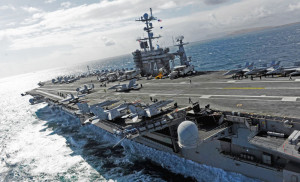
Beginning from the early 1990s, the gaining momentum China started its triumphal rise to power in this region energetically waving the banner clearly demonstrating its intention to return the territories and influence it had allegedly lost in the so-called “period of historic weakness.” It was a natural course of things for China, which had adopted a new policy, to start gradually pushing the United States, dominating after the WWII in the local military and economic domains, out of the region. Basically, China employed “the carrot and stick” approach, simultaneously expanding its presence in the South China Sea and offering lucrative economic projects to the countries of the ASEAN. The Chinese were building their policy around the core idea of the establishment of a free trade zone between China and the ASEAN. And their undertaking proved very successful. In 2005, the mutual goods turnover between China and the ASEAN exceeded $100 billion. In 2013, it reached $443.6 billion and by 2020, the parties are hoping to meet the $1 trillion milestone.
Engagement in the cooperation of this sort means that China would have to calculate with high precision when to capitalize on its economic dominance and gain political weight. China has already made several attempts, but they were unsuccessful. Since the ASEAN member states are not willing to give up their freedom of action, China is forced to continuously step up its efforts. The most influential countries of the ASEAN are willing to go as far as signing an agreement on special reciprocal partnership with China, provided that it would not impose any addition obligations on them.
Attempts of the ASEAN countries to pursue their own interests and to resist Chinese expansionism more often than not irritate China. What really annoys Beijing is the regular appeals of the ASEAN’s elite to the United States for protection and its commitment to the internal cohesion and unity (this is one of the favorite topics that the ASEAN politicians, especially those from the largest and most influential country in the region Indonesia, like to harp on). As for the regional trade and the free trade zone, the ASEAN member states are demonstrating a strong desire to offset China’s influence there by “dissolving” the borders of the free trade zone so as to increase China’s dependence on other partner states.
China was most successful developing relations with the poorest countries of the ASEAN, e.g., Cambodia and Laos. To boost its influence there, China would issue loans on favorable terms and stimulate an increased goods turnover and a revival of the local production. Local Chinese diasporas also played a vital role in the strengthening of China’s influence in these countries.
It appears that Americans were taken by surprise by such energetic Chinese “offensive.” They were obviously inadequately slow to make “a historic turn toward Asia,” and implement the idea of a trans-Pacific partnership. Having been misled by the appeals of Filipino politicians and Singaporean businessmen (the latter literally begged the US to return to Asia), Washington sincerely believed that the region was anxiously waiting for the US to appear on the local scene again. Americans thought that it would take some political will and a modest handout to create a “block post” from the ASEAN member states surrounding China and, thus, mitigate the Chinese expansion. It was envisaged that the countries of the “block post” (the Philippines, Vietnam, Thailand and Burma) supported by the US would counterbalance the Chinese expansionism. The United States hoped that by implementing this plan, it would get a powerful tool for manipulating China in the bilateral US-China relations.
However, it seems that something went wrong with this plan. What’s more, it looks like the countries of the ASEAN have used the US to their advantage and created their own system of counterbalances. The whole idea of the system of “block posts” has fallen into oblivion, and if before it was quite clear who was backing the US in the region (the Philippines and Thailand, as well as Singapore), today it is not obvious at all. There is a split between the member states of the ASEAN. Some are looking to establish balanced relations with both the United States and China. Others (like Cambodia) act as a principal conductor of Chinese interests in the ASEAN bloc. Even Vietnam, which was so close to becoming a US ally, has pulled out of the prospective deal and is now shaping a multifaceted foreign policy developing relations with both the United States and China.
At the same time, the ASEAN’s two-track approach that allowed to bring the United States back to the region and create a rather successful system of checks and balances between Washington and Beijing, seems very risky. The US and China have been escalating their military presence in the region. If the former is deploying new submarines, the latter is building artificial islands intended as unsinkable aircraft carriers. The armed confrontation is on the rise and there is no guarantee that the countries of the ASEAN will have a say or, moreover, keep the situation in the region under control.
Dmitry Mosyakov, Professor, PhD, Head of the Center for Southeast Asian, Australian and Oceanian Studies, Institute of Oriental Studies, Russian Academy of sciences, exclusively for the online magazine “New Eastern Outlook.“
